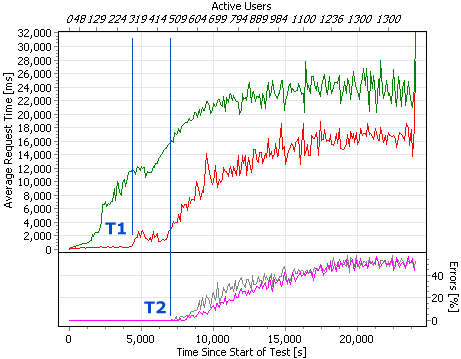Probing the limits of a server
Comparing request times of a static HTML file vs. a CGI Script
This sample shows the results of a 400 minute ramp test with up to 1.300 users accessing two URLs of a webserver every 7 seconds. One URL is a static HTML file (Homepage) and the other URL is a CGI script.
We can see that with the rising number of users the request times of the CGI script (green line) increase much faster than the request times for the static HTML page (red line). In fact until about 300 simultaneous users (marked with “T1”) the request times for the static file don’t change much at all.
Then as the number of users crosses the 500 mark (marked with “T2”) we can see that the first requests produce errors. The graph of the percentage of errors (gray and pink line) goes up from 0% and keeps rising up to 50% until the end of the test.
Conclusion: We can conclude that this server can support about 80-100 users clicking either link every 7 seconds with an average click time of 2 seconds. But with more than 100 users the request times (especially those of the CGI) increase substantially. This server can not support more than 500 users because with higher loads up to 50% of the requests produce errors.
Test Results
| Maximum Pageviews | ~78.000 pageviews per hour |
| Maximum Server Bandwidth | ~750 kBit/s |

Test Setup
| Test Type | RAMP (number of users increases during the test time) |
| Number of Users | 1300 |
| Click Delay | 7 sec |
| Tested Web Server | DELL Dimension, 1.5 Ghz Intel P4, 400 MB RAM, SUSE Linux 9.1, Apache 2 (out-of-the-box installation), 100 MBit Network |
| Test Client | DELL Poweredge 750, 2.8 GHz Intel XEON (Hyperthreading), 2 GB RAM, Windows 2003 Server, (out-of-the-box installation) (running Webserver Stress Tool) |